
 |
|||||
|
|
|||||
|
|
|
|||||
|
|
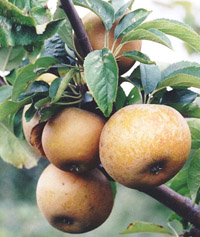 |
EGREMONT RUSSET A very well known dessert variety and the russet known so well that it has almost become synonymous with ‘russets’ in the modern mind. It is also a perfect example of an apple widely sold which fails to reach its potential for having been cropped too early by commercial growers. It is so much better when grown by the amateur and left until the zenith of ripeness, when it also carries its richer flavour into storage. The early history was lost and it was not until 1872 that the name first appeared – as a title only in John Scott’s ‘The Orchardist’. It has sometimes been said to have been raised on Lord Egremont's estate at Petworth, in Sussex. The fruit is medium sized and heavily russeted, with a little light green showing through. In some warm summers, in some places, the skin develops rich red patches. The flesh has a sweet, nutty taste which becomes richer on storage. Apples are ripe in October and keep until December, though the fruit becomes softer, crumblier and dryer with age. Trees have an upright habit, crop well and spur freely for use in espaliers and cordons. Over the 20th century, it was also widely grown in Europe and America. It still is. The only care needed with Egremont Russet is with early frosts and pollination. It is early flowering and sometimes suffers poor crops for lack of a pollinating partner, flowering at the same time. Pollination Group 2 |
||
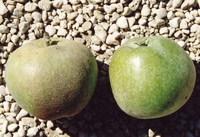 |
ELDON PIPPIN An English dessert apple, also used as a cider ‘sweet’. It was raised in Lower Eggleton, near Ledbury, Herefordshire, by Mr William Hill. A small to medium sized, late season apple, it was first recorded in the 1842 collection catalogue of the London Horticultural Society, where it was described as being yellow, brown and red, roundish, middle sized, for table use, of top quality and ripe from January to April. (Though Hogg says it first fruited in 1847). In 1872 it was first fully described in Scott’s ‘The Orchardist and it was exhibited from Veitch’s nursery at Chelsea and Frogmore in Berkshire, at the 1883 National Apple Congress at Chiswick, where it was described by Barron, the author of the report, as being for dessert, medium sized, flat, orange-yellow, streaked, sweet, mid season and of first quality. It was last described by Hogg, in ‘The Fruit Manual’ of 1884. He described it as being small, round, somewhat oblate and angular, prominently ribbed around the eye. The skin is yellow on the shaded side, almost entirely covered with thin crimson and streaked with darker crimson on the side near the sun. The flesh is yellowish or greenish yellow, very juicy, sweet and richly flavoured with a fine aroma. Apples are in use from December to April. The descriptions are broadly consistent, give or take the normal variations from year, place and climate. After 1884, it appeared to be ‘lost’ in Britain and elsewhere, but we found it listed in the Heritage Collection at Grove Farm in Tasmania, the only listing amongst all the major world collections. Like many other ‘lost’ English apples, this had presumably found its way to Australia with a settler and continued there. They sent scions to us in 2005. It is certainly the true Eldon Pippin and if we added anything to the above descriptions it would be that the colouring is more tawny than bright red, that the russet can be quite pronounced and that it is not fully ripe until November. It is a very good apple. Pollination Group 5 |
|||
 |
ELIZA
OF FRINGFORD One of three old apples growing in a small orchard
at the Old Rectory, built in 1680, in the pretty village of Fringford,
Oxfordshire. Brought to our attention by the owner, Charles Hebditch,
none of these apples appear to be varieties currently known. Fringford
owes some celebrity to it being the fictional ‘Candleford Green’
created by Flora Thompson in ‘Lark Rise to Candleford’. She
lived at Fringford and worked in the post office there, in her early adulthood.
This now-small old hollow tree bears small to medium sized pale yellow
flattened rounded apples which ripen in late August and will not keep
into November without losing condition and flavour, but for a few weeks
they are quite excellent. The flesh is very crisp but fine, very juicy,
sweet and tangy, with a good flavour hinting at Parma Violets. Very good
for an early apple. Pollination Group 3 |
|||
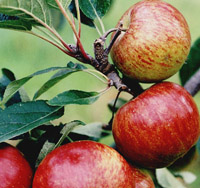 |
ELLISON’S
ORANGE A middle season eating apple, dating back to 1904, and
raised by Rev. Ellison of Bracebridge and Mr Wipf, head gardener to Rev.
Ellison's brother in law at Hartsholme Hall, in Lincolnshire. Rev. Ellison
was a renowned pomologist and fruit grower, with over 1500 fruit trees,
early in the 20th century. Crisp, juicy fruit with a rich, almost aniseed,
flavour. A cross between Cox’s Orange Pippin and Calville Blanche
D’Hiver. Good crops, though sometimes biennial. Trees fruit when
quite young. Free spurring. Pollination Group 4 |
|||
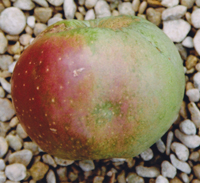 |
ELMHAM
MILL A very old variety, by its appearance, but one for which
the original name cannot now be determined. It was brought to us by Adrian
Cadman of Elmham Mill, a redeveloped property on the River Wensum at Worthing,
Dereham, Norfolk. The large, old, decrepit tree stands alone close to
the bank of the river and in an unlikely planting spot for an early 18th
century mill, but an even more unlikely spot after the mill closed. A
very late season apple of pale green, washed with brown in the sun, and
with prominent spots. Scaly russet extends from the eye and stalk over
the body like a weathered face. The eye is very unusual, offering a view
deep into the apple. By November it is ready to be cooked to give a sharp,
rich purée. An apple that shouts antiquity. The apple will store
into the next year. |
|||
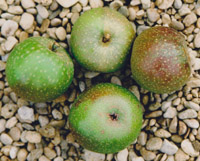 |
ELMORE
PIPPIN A very late season dessert apple which appears to have
originated at Elmore in Gloucestershire. Old trees are still to be found
in the area. The first formal record was in 1949 when it was sent to the
National Fruit Trials. A medium sized, rounded apple with slightly flattened
ends, mostly green becoming pale yellow, with sometimes a warm blush and
with prominent lenticels. The apples hang on the tree into December and
are quite sharp until then. The flesh is very chewy and never with sufficient
juice, but it does develop a very rich sweet flavour if patient. It is
unlikely to receive a sufficiently long season in the north. Pollination
Group 5 |
|||
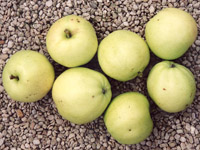 |
EMNETH
EARLY Also known as Early Victoria, Emneth Early is a valuable
early cooking apple, sometimes ripe as early as late July and which can
even be stored until Christmas. It was raised by William Lynn of Emneth,
in Cambridgeshire, crossing Keswick Codlin with Lord Grosvenor. Bunyard,
in ‘A Handbook of Fruits’ (1920) records that it was introduced
by Messrs Cross of Wisbech in 1899. It was soon grown more widely around
the country and was valued in Eastern Europe for its hardiness and heavy
crops. The fruit is often so full that some thinning is best to avoid
small fruit and sending the tree into biennial cropping. Trees produce
spurs abundantly and are hardy, upright and compact. When cooked, the
apples break down, to a froth, when fully cooked, with a good flavour
and needing little or no sugar. If cooked gently they will keep some shape.
Flower buds are rich red-pink, opening to large pink flowers, for a fine
display. Pollination Group 3 |
|||
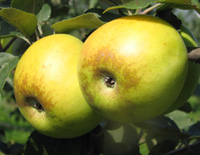 |
ENGLISCHE
SPITALRENETTE When the 18th century Sykehouse Russet, from the
village of Sykehouse in Yorkshire, made the journey to Germany, about
1809, the name suffered an error in translation. Sykehouse was taken to
mean Sick-House and the apple was introduced in Germany as Englische (English)
Spital (Hospital) Renette. With many similar synonyms, it has happily
resided there while it became very rare in Britain. In Germany, now long
aware of the original error, it still goes by the name of Englische Spitalrenette.
There has been much debate as to whether the apple Sykehouse Russet still
known in Britain (and grown by us) is the correct one. It might also be
speculated that the Englische Spitalrenette might equally have become
confused with others after 200 years, but it seems to have an equal claim,
fully matching the old descriptions in England. In Germany it is described
as being a small eating apple, yellow skinned with sometimes a little
orange red, and with variable russet. The flesh is cream-coloured, firm,
later crumbly, vinous, sweet and with good acidity. Trees are healthy
and vigorous. We are grateful to Matthias Buchta of Bavaria for sending
us scions in 2019. |
|||
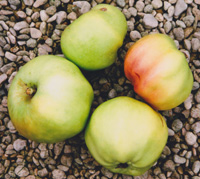 |
ENGLISH
CODLIN Codlin is the old name for a class of cooking apple; to
coddle is to cook gently, so Codlins need little cooking to become soft
and tender. The English Codlin is one of the oldest English apples, once
widely grown throughout the country. It is a large cooking apple, which
can be used before fully ripe but is actually ripe midseason. It has the
characteristic codlin shape and white, juicy flesh which is soft, fluffy
and delicately perfumed when cooked. It can be used from August until
October, though its use can be extended. Parson Woodforde in his diaries
of 1774 said that he had given a dinner at New College, Oxford, which
included a Codlin Tart, with cream, on July 27th. The tree is vigorous,
with abundant crops. Pollination Group 3 |
|||
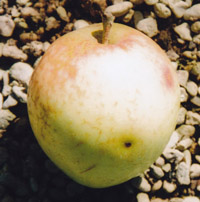 |
ENGLISH GREENING An
old American late apple with a strong English connection, from the third
oldest living ‘provenanced’ apple tree in the world, after
the original Bramley and Milton Wonder, (see later). The tree was known
to have been planted in 1826 at Fort Vancouver, Washington State. It was
planted as ‘English Greening’. After some research and valuable
assistance from Ryan Durocher, Urban Forestry Co-ordinator at the City
of Vancouver, who also kindly sent us scionwood, the history of the tree
is as follows: An English lady at a farewell dinner, for Emilius Simpson,
cousin of Hudson's Bay Governor, Sir George Simpson, gave him the seeds
from her dessert apple and asked him to plant them at the fort. Dr. John
McLoughlin planted five apple seeds, and the ‘Old Apple Tree’
is the only remaining tree that grew from those seeds. Every year, a festival
is held to celebrate the tree on the first Saturday in October at the
historic Apple Tree Park, 112 Columbia Way, Vancouver. Medium sized apples,
longer than wide, oval to truncate conic, ribbed and knobbed around the
eye. The skin is pale green, turning yellow with a warm blush in the sun,
with some netted russet. An apple that remains hard until late in the
season. It stores well. Sharp, but rich flavour. Very attractive blossom.
Pollination Group 2 |
|||
|
||||